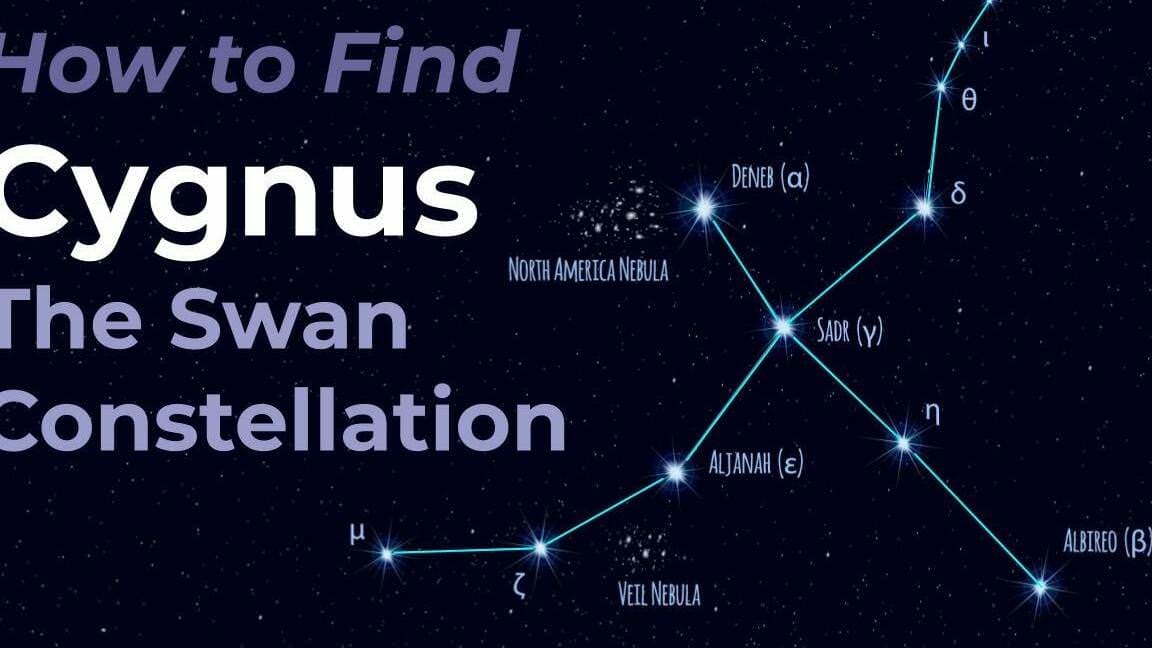The swan is a highly noticeable constellation that can be found in the northern sky. Its Latin name, “Cygnus,” translates to “swan.”
It is connected to the mythological story of Zeus and Leda. Locating this constellation is relatively easy as it contains the well-known asterism, the Northern Cross. Ptolemy included this constellation in his catalog during the second century.
Notable objects within the constellation include Swan X-1, the bright stars Albireo and Deneb, the Fireworks Galaxy (NGC 6946), and several renowned nebulae: the Pelican Nebula (IC 5070), the North America Nebula (NGC 7000), the Crescent Nebula (NGC 6888), and the Veil Nebula (NGC 6960, 6962, 6979, 6992, and 6995).
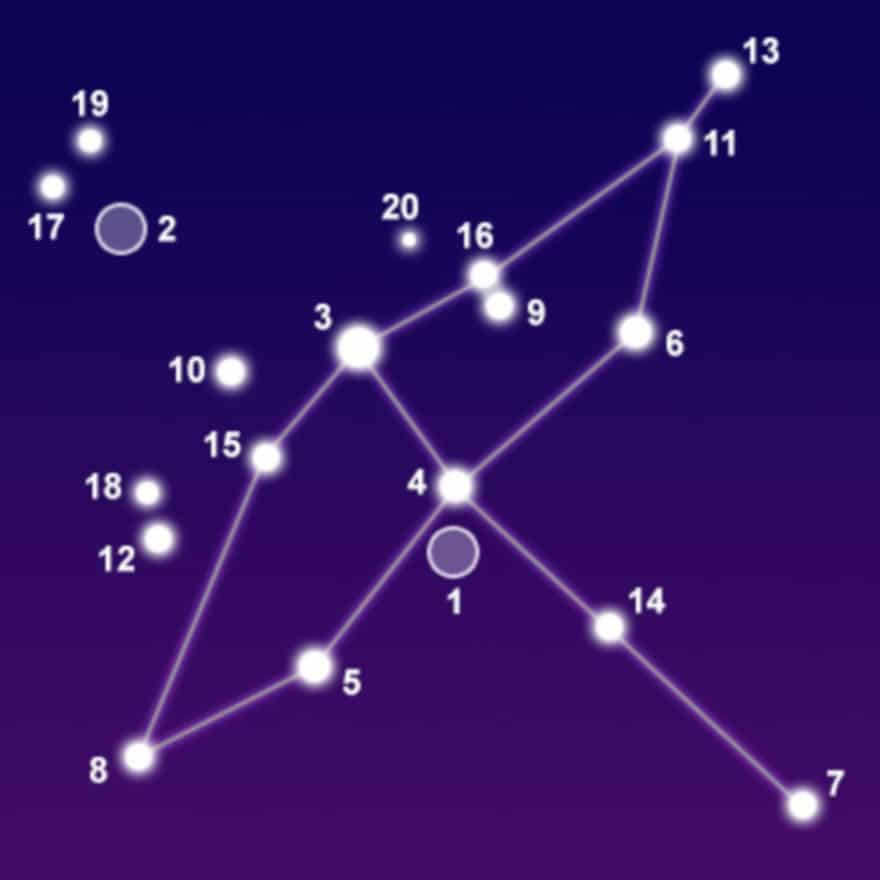
Interesting Facts, Location, and Star Map
The constellation Swan, also known as Cygnus, covers an extensive area of 804 square degrees, making it the 16th largest constellation in terms of size. Positioned in the fourth quadrant of the northern hemisphere (NQ4), it can be observed at latitudes ranging from +90° to -40°. Cygnus shares its borders with the constellations of Draco, Lyra, Pegasus, Vulpecula, Lacerta, and Cepheus.
This celestial region is home to a remarkable collection of celestial objects. Within its boundaries, you can find 10 stars known to have planets and two notable Messier objects, namely Messier 29 (NGC 6913) and Messier 39 (NGC 7092). The brightest star in Cygnus, known as Deneb, ranks 19th in terms of apparent magnitude with a value of 1.25. Additionally, this constellation is associated with two meteor streams, namely the October Cygnids and Kappa Cygnids. For a visual representation of the Swan constellation, please refer to the accompanying star map.
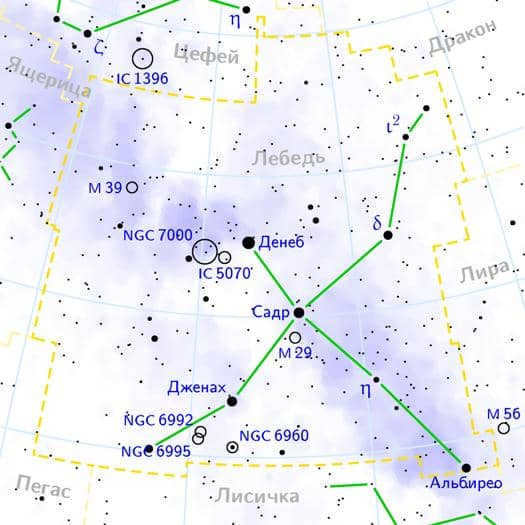
Legend
There are various legends associated with the constellation. The most common one is about Leda, the queen of Sparta. She gave birth to two immortal twins, Pollux and Helen, as well as two mortal children, Castor and Clytemnestra. Leda was seduced by Zeus, who transformed into a swan.
Another myth involves Orpheus, who is sometimes depicted as a swan. This Greek hero was murdered by Thracian Maenads for refusing to worship Dionysus. After his death, he transformed into a swan and found a place in the sky alongside Lyra.
Additionally, those with the Latin name “Cygnus” are sometimes considered representatives of the constellation: this includes Areus’ son (who died in a battle against Heracles), Poseidon’s son (who fought for the Trojans and was killed by Achilles), and a close friend of Phaeton (Helios’ mortal son and the god of the Sun). Among these individuals, the last one is the most frequently mentioned in myths. Phaethon and Cycnus were traversing the celestial realm when they ventured too close to the Sun. Their chariots caught fire and they plummeted to the ground. While Cycnus survived, he discovered that his friend had drowned in the River Eridanus. In response, he beseeched Zeus to allow him to spend the remainder of his life in the form of a swan. Reborn as a swan, he dived into the river and retrieved Phaethon’s lifeless body. Cycnus then laid him to rest in accordance with tradition, ensuring his peaceful afterlife. Zeus was so moved by this act of sacrifice that he elevated Cycnus to the heavens, transforming him into a swan.
There is a legend in China known as the “forty bridge.” This tale tells the story of Zhi Nu, a fairy who fell in love with a mortal named Nu Lang. Their love was forbidden, and the Goddess of Heaven prohibited them from meeting. Despite this, they secretly wed and the goddess took Zhi Nu into the sky, creating a river (the Milky Way) to keep them apart. Nu Lang sent their children to heaven in hopes of reuniting with his wife, but the goddess showed no mercy and denied him entry. However, this heartwarming love story touched the world so deeply that once a year, all the magpies gather near the river and form a bridge with their bodies. This bridge is symbolized by the constellation Swan.
The primary celestial bodies
The prominent stars in the Northern Cross constellation include Deneb, Delta Swan, Albireo, Epsilon Swan, and Gamma Swan.
Deneb, also known as Alpha Swan, is a blue-white supergiant (A2 Ia) located approximately 1400 light-years away. It has an apparent magnitude of 1.25, making it the brightest star in the constellation and the 19th brightest star in the entire sky.
Deneb serves as a representative example of the Alpha Swan variable star class. Its brightness and spectral type exhibit slight variations due to surface irregularities that are not radial in nature. Additionally, this star has ceased hydrogen fusion in its core, indicating that it will eventually undergo a supernova explosion within the next several million years.
With a magnitude of -7.0, it is widely recognized as one of the most brilliant stars. It shines nearly 60000 times brighter than the sun and has a mass equivalent to about 20 suns. This star holds the title for being the most distant star with a magnitude of 1. Additionally, it is renowned as one of the most famous white stars. Interestingly, on Mars, Dhaneb serves as the north pole star.
Dhaneb, derived from Arabic, translates to “tail” (specifically, from the phrase Dhanab ad-Dajājah, meaning “tail of the chicken”). In Chinese folklore, this star symbolizes the bridge or fairy itself in the myth of the “Bridge of Forty”. Alongside Altair (Eagle) and Vega (Lyra), it forms the Summer-Fall Triangle asterism.
Sadr (Gamma Swan) is a supergiant star of F8 spectral class, situated at a distance of 1800 light-years. With an apparent magnitude of 2.23, it stands out as one of the most prominent stars visible in the night sky. Its mass exceeds that of the Sun by a factor of 12, resulting in a faster depletion of its nuclear fuel. It boasts an age of 12 million years.
Enveloping this star is a diffuse nebula known as IC 1318, adding to its mesmerizing allure. Positioned at the junction of the Northern Cross, its name “Sadr” originates from Arabic, meaning “chest.” Another designation, “Pectus Gallinae,” derived from Latin, translates to “chicken chest.”

The IC 1318 nebula is an example of an emission nebula.
Jenach (also known as Epsilon of the Swan) is classified as an orange giant star of spectral type K0 III. It has an apparent visual magnitude of 2.480 and is located approximately 72.7 light-years away. Jenach is 62 times brighter than the Sun and has a radius 11 times larger. It has a companion star with a magnitude of 13.
Jenah shares its name with Gamma Raven, which is found in the constellation Raven. The name “Jenah” translates from Arabic to mean “wing”.
Delta of the Swan is a triple star located in the Swan constellation. It has a combined apparent visual magnitude of 2.87 and is situated approximately 165 light-years away. It is predicted to become Polaris around the year 11250.
Its nearest partner is a star that is yellow-white in color and has a brightness level of 6.33. The third star in this system is an orange giant with a brightness level of 12.
Albireo (Beta Swan) is a binary star system that is easily visible even with a small telescope. It is situated at a distance of 380 light-years. It is the fifth brightest star in the constellation. It can be found in the head of the Swan and is sometimes referred to as the “beak star”. It is a part of the Northern Cross.
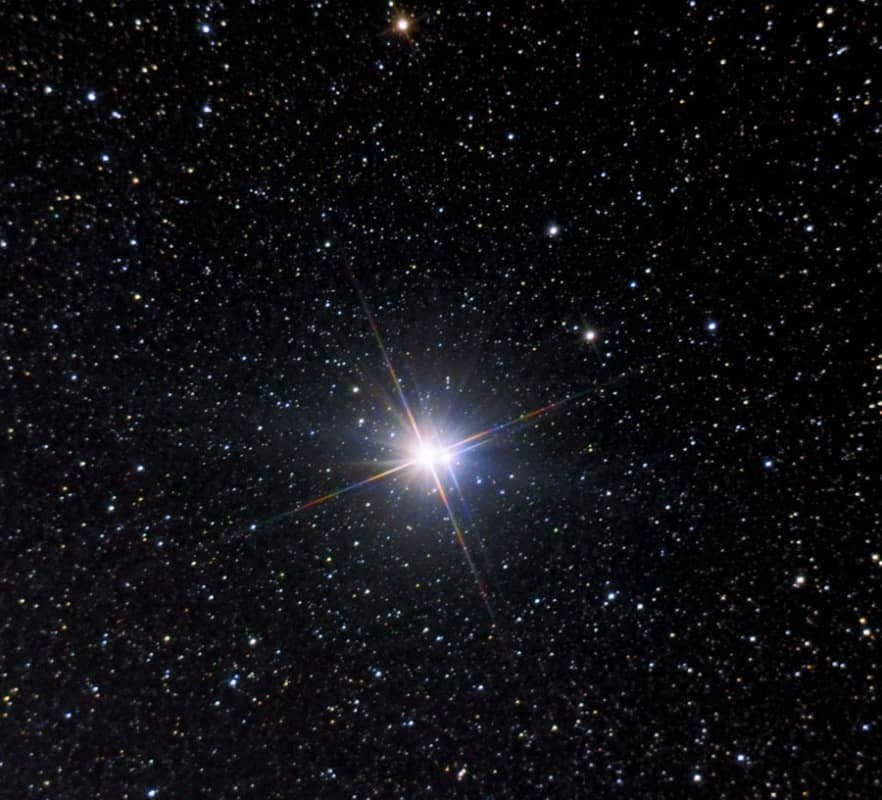
The Albireo system is composed of a bright yellow star, with a visual magnitude of 3.18, and a faint blue companion, which has a visual magnitude of 5.82. These two stars are separated by an angular distance of 35 arc seconds. Due to this striking contrast, Albireo is a popular target for amateur astronomers.
Albireo A consists of two stars that are separated by 9.4 arc seconds, making it difficult to resolve without a telescope larger than 20 inches. The primary star has a spectral classification of K3III.
Albireo B is a rapidly rotating star of spectral type B0V, with a velocity of 250 km/s.
Tau Swan is made up of two stars – a subgiant GJ 822.1 A (F2IV) and a main-sequence star GJ 822.1 B (G0V). The second star is similar to the Sun in terms of size, brightness, and temperature. The magnitudes of these stars are 3.84 and 6.44, respectively. The distance between our solar system and Tau Swan is 68.2 light-years.
Swan Cap is a giant star with a spectral type of G9 III. It has a visible magnitude of 3.814 and is located 124.2 light-years away. You can easily see Swan Cap without any special equipment. Interestingly, there is a meteor shower called Kappa Cignida that is associated with this star. It appears about 5 degrees north of Swan Cap and happens every August.
This particular Swan is an orange giant star (K0III) located 139 light-years away. Its visible magnitude is 3.909.
Pi Swan is actually made up of two star systems. Pi-1 Swan is a star that belongs to the spectral type B3IV and has a visual magnitude of 4.67. It is located at a distance of 1,680 light-years from us. The star is known as Azelfage, which is derived from the Arabic phrase al thīlf al faras, meaning “horse trail,” or from al’azal al-dajājah, meaning “chicken tail.”
On the other hand, Pi-2 Swan is a double star system observed through spectroscopy. The main star in this system is a blue giant of type B3, and it is a staggering 2200 times brighter than our Sun. This star has a total magnitude of 4.23 and is located 1156 light-years away. It has two names: “Pennae Caudalis” in Latin, which translates to “fathers of fathers,” and “Sama al Azrak” in Arabic, meaning “blue sky.”
61 Swans is a binary star system made up of two dwarf stars with spectral types K5V and K7V. These stars revolve around each other every 659 years. The apparent visual magnitudes of the stars are 5.21 and 6.03. The system is located 11.41 light-years away, making it the 15th closest system to us.
What sets 61 Swans apart is its own motion, which is a change in position over time that can be observed from the system’s center of mass. This phenomenon was initially observed by Giuseppe Piazzi, an Italian astronomer and mathematician, in 1804. Piazzi referred to it as the Flying Star.
61 Swan was the initial celestial body (apart from the Sun) that scientists were able to measure the distance to. This groundbreaking achievement was accomplished by Friedrich Wilhelm Bessel, a German astronomer, who employed the parallax method. Bessel calculated the shift in the star’s apparent position as observed from two distinct lines of sight, as well as the angle of inclination between these lines. The unique motion of 61 Swan made it an ideal subject for these calculations.
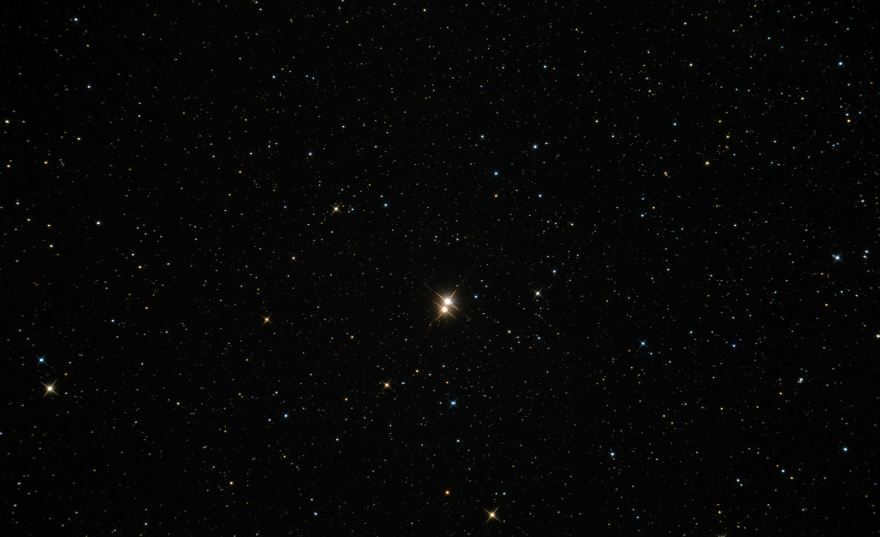

61 Swan is a Bessel’s star.
P Swan (34 Swan) is a bright blue variable hypergiant of spectral class B1Ia +. It is situated at a distance of 6,000 light-years. This star is one of the most luminous ones observed in the Milky Way. Luminous blue variables are extremely rare and are found only in regions of intense star formation. They have short lifetimes as they rapidly deplete their nuclear fuel and eventually evolve into supernovae within a few million years. In contrast, our Sun has existed for billions of years.
Willem Blaeu first observed the star in August 1600. It remained elusive until then because it was only visible as a third magnitude star at the beginning of the 16th century. The star disappeared in 1626, reappeared in 1655, and persisted until 1662. By 1715, the star had finally stabilized its brightness fluctuations. It currently has a magnitude of 4.8, with occasional dips down to 0.5.
Johann Bayer identified the star as P and classified it as a nova. It is sometimes called a permanent nova due to its dramatic changes in brightness.
39 Swan is an orange star (K3III) with an apparent magnitude of 4.436 and a distance of 260 light-years. It is cooler than the Sun but significantly brighter and larger. Its surface temperature ranges from 3500 to 5000 Kelvin.
The star is fascinating because it has the potential to host a planet from another solar system. The ELODIE team has observed changes in the star’s radial velocity, indicating the presence of an object orbiting it with a period of less than six months. This potential planet is estimated to be twice the size of Jupiter, although its existence has not yet been confirmed.
16 Swans is a unique triple star system. The two brighter stars are similar to our own sun, with apparent magnitudes of 5.96 and 6.20. The third star is a red dwarf. This system is located approximately 70 light-years away from us. Interestingly, a planet has been discovered in orbit around the second star, following an eccentric path.
Gliese 777 (HD 190360) is a yellow subgiant star (G6IV) situated 51.81 light-years from Earth. It has an apparent magnitude of 5.71. In 2005, scientists discovered the presence of two exoplanets within this star system. Additionally, there is a companion object – a faint red dwarf (M4.5V) – located at a distance of 3000 astronomical units. This companion has a visual magnitude of 14.40 and may even be a binary star system.
The Swan’s Omega (Ruhba) – is made up of two distinct duplicates that are 1/3 degree apart. The customary term Rukhba has its roots in Arabic and means “knee of a chicken”. Omega-1 is a scorching subgiant (B2.5) with a visual magnitude of 4.95 and is positioned at a distance of 910 light years. Omega-2, on the other hand, is a red giant (M2III) with a magnitude of 5.22 and can be found 400 light-years away.
Celestial objects
Messier 29 (M29, NGC 6913) is a cluster of stars that can be seen with binoculars. It has an apparent visual magnitude of 7.1 and is located 4000 light-years away. Charles Messier discovered it in 1764 near the star Gamma Swan, which is located 1.7 degrees south and slightly east.
This star cluster is approximately 10 million years old. The brightest star within the cluster has a visual magnitude of 8.59. The five hottest stars in the cluster belong to the spectral class B0.
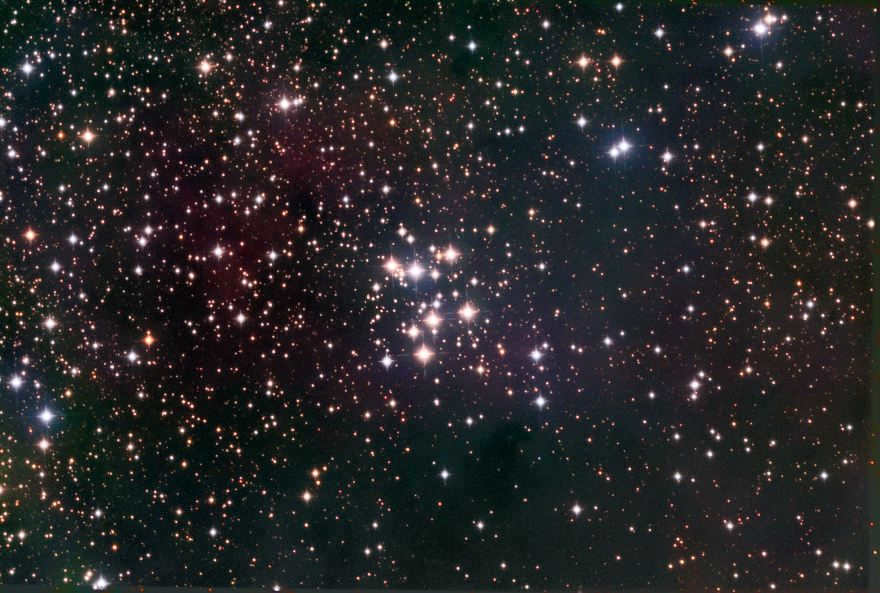

Messier 39 (M39, NGC 7092) was first discovered in 1764 by Charles Messier. It has an apparent visual magnitude of 5.5. The brightest star in the cluster is classified as spectral class A0 and has a visual magnitude of 6.83. All of the stars in the cluster are part of the main sequence, with the brightest ones eventually evolving into red giants.
The cluster is estimated to be around 200 to 300 million years old, making it an intermediate-aged open cluster. It is located approximately 800 light-years away from our solar system and can be found 2.5 degrees to the west and south of the star Pi-2 Swan.
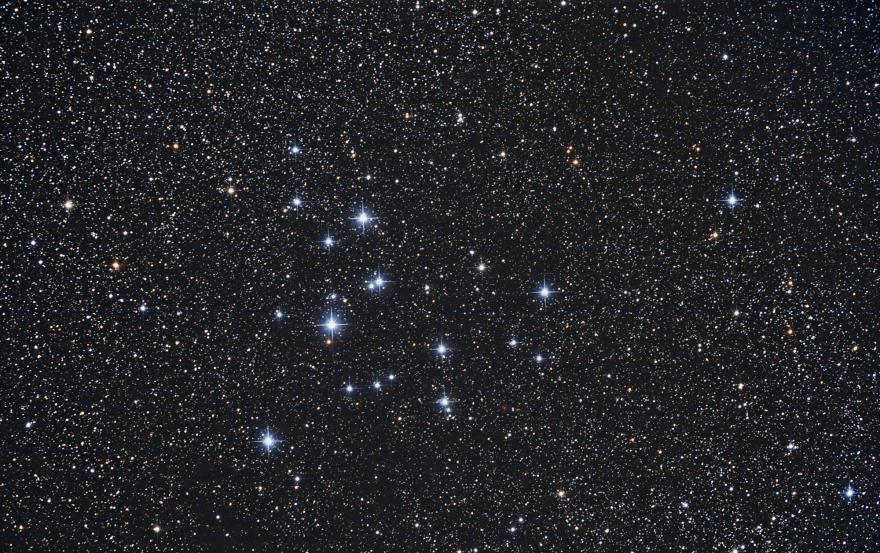
The Fireworks Galaxy (NGC 6946, Arp 29, Caldwell 12) is a spiral galaxy of intermediate size, with a visual magnitude of 9.6. It is situated approximately 22.5 million light-years away in the vicinity of the constellation Cepheus. Due to its proximity to the galactic plane, it is partially obscured by the interstellar matter of our own Milky Way galaxy.
On September 9, 1798, the Fireworks Galaxy was first discovered by Frederick William Herschel. Since then, astronomers have observed a total of 10 supernovae within this galaxy, including SN 1917A, SN 1939C, SN 1948B, SN 1968D, SN 1969P, SN 1980K, SN 2002hh, SN 2004et, and SN 2008S.
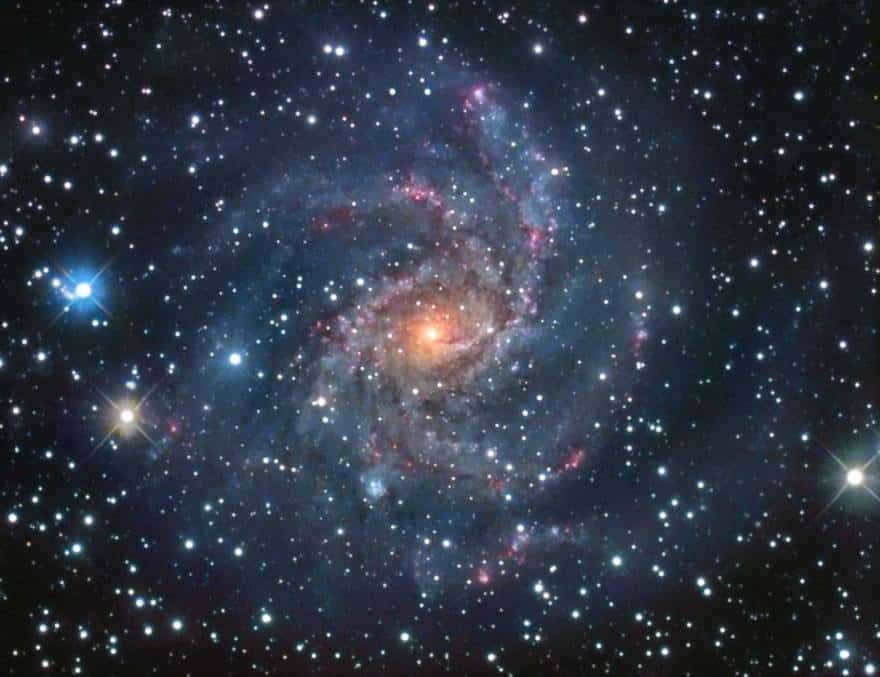
Swan X-1 was discovered in 1964 during a rocket flight and is well-known for emitting X-rays. It was the first object to be considered a potential black hole. With a mass 8.7 times that of the sun, it is believed to be a black hole due to its compact size. Located 6,100 light years away from us, Swan X-1 orbits the blue variable star HDE 226868, forming a binary system. Over time, an accretion disk composed of stellar wind material has formed around Swan X-1.
The North America Nebula (NGC 7000, Caldwell 20) is a emission nebula that has a visual magnitude of 4 and is located about 1600 light-years away. It obtained its name due to its distinct shape resembling the continent of North America, which is formed by the overlapping of a dusty band.
This nebula is classified as a large one and spans an area of approximately 120 by 100 angular minutes. However, it is usually not visible to the naked eye due to its relatively low surface brightness, requiring the use of binoculars for observation.
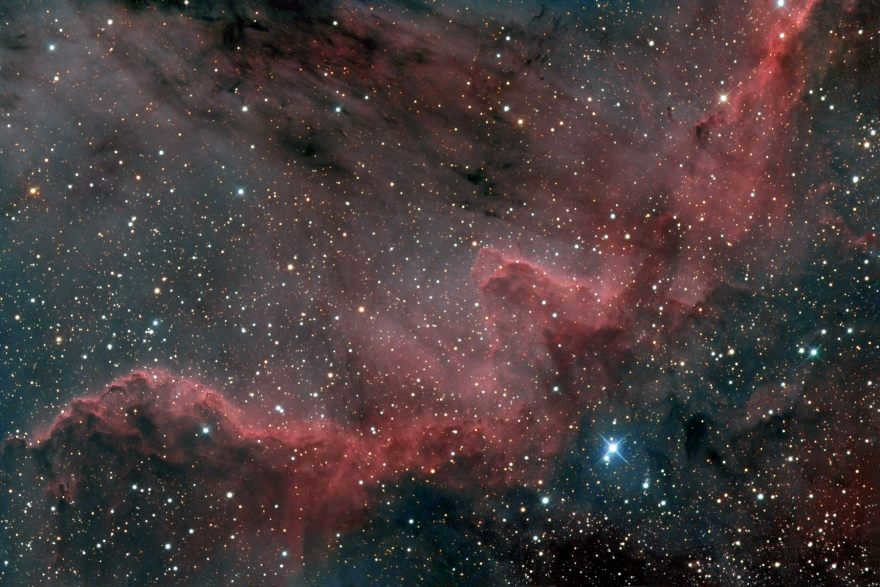
The NGC 7000, also known as the North America Nebula, was discovered by William Herschel on October 24, 1786. The region of the nebula that corresponds to the location of Mexico and Central America is known as the Swan Wall, and it is where the greatest concentration of star formation occurs. The North America Nebula is part of the H II region, which is an interstellar cloud where stars are formed, and it is also associated with the Pelican Nebula (IC 5070).
The Pelican Nebula, also known as IC 5070 and IC 5067, is an emission nebula that has an apparent visual magnitude of 8.0 and is located approximately 1800 light-years away. It is named after the bird it resembles.
If you want to find the Pelican Nebula, just direct your gaze towards the northeastern direction of the bright star Deneb.
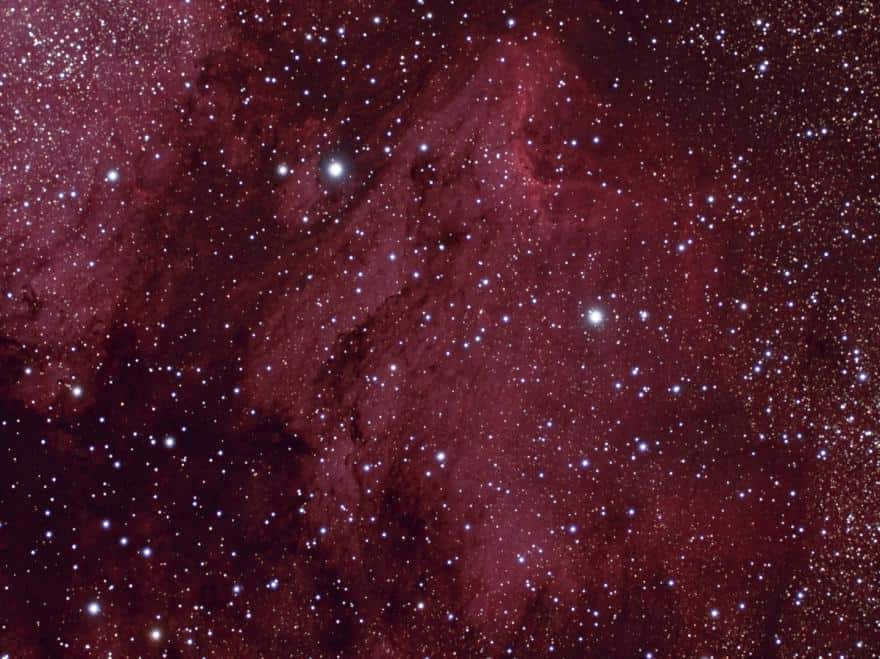
Pelican Nebula – IC 5070
The Sadr Region (IC 1318) is an emission nebula formed around the star Sadr (Gamma Swan) situated at the intersection of the Northern Cross.
The Crescent Nebula (NGC 6888, Caldwell 27) is an emission nebula formed as a result of the powerful wind produced by the Wolf-Rayet star HD 192163 (WR 136), an old, hot, massive star that is rapidly shedding mass. It transformed into a red giant approximately 400,000 years ago, and its influence shaped the nebula. The size of the Crescent Nebula is 18′ x 12′ with an apparent magnitude of 7.4 and a distance of 5000 light years.
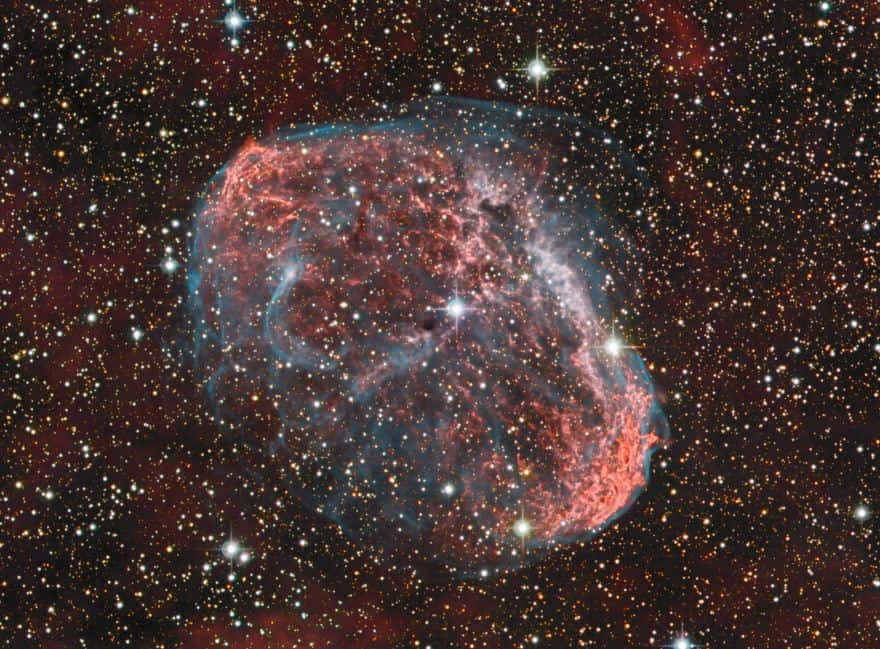
The NGC 6888, also known as the Crescent Nebula, is an expansive supernova remnant that stretches across 3 degrees of the sky. This celestial formation takes the shape of an emission nebula and emits a significant amount of soft X-ray radiation. The intricate structure of the Swan Loop can be observed in various forms of light, including radio waves, infrared radiation, and X-rays.
One notable feature within the Swan Loop is the Veil Nebula, also referred to as the Fish Net (NGC 6960, NGC 6992, NGC 6995, NGC 6974, NGC 6979, IC 1340). The Veil Nebula is a visually captivating component of the Swan Loop and is composed of multiple sections, including the Western Veil (NGC 6960), the Eastern Veil (NGC 6992, NGC 6995, IC 1340), and the Fleming Triangle (Pickering Triangle).
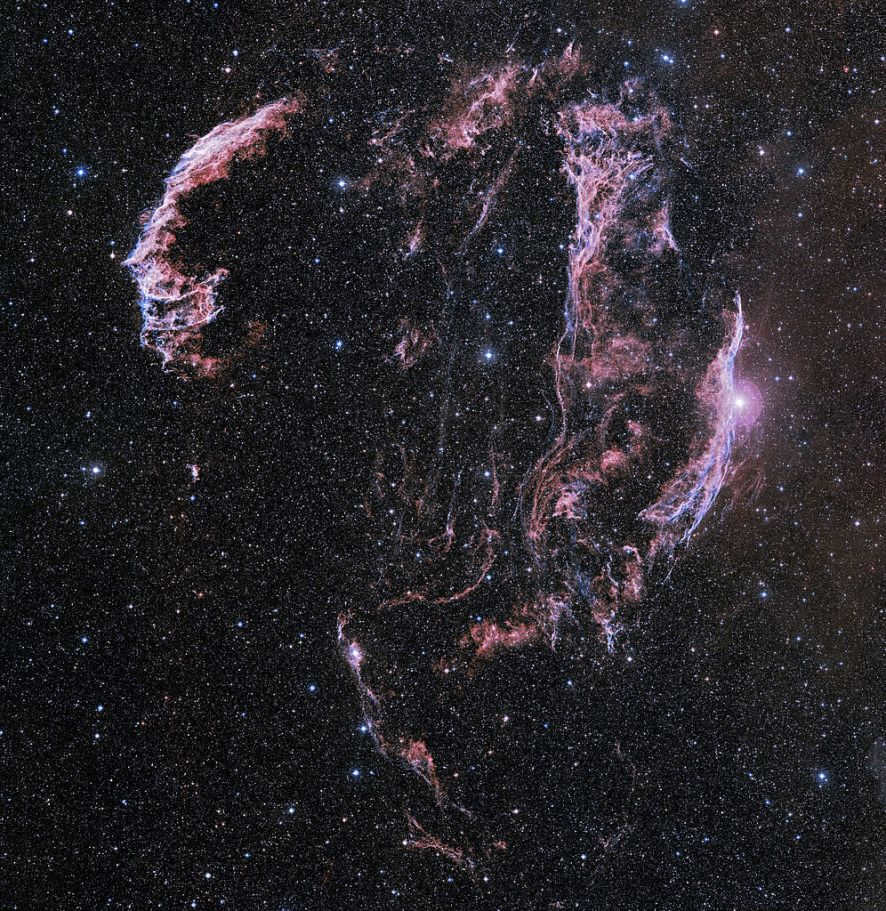

The Veil Nebula is composed of multiple color photographs.
NGC 6960 represents the western veil (known as the Witch’s broom), which is the largest section in the western part of the nebula.
The eastern veil consists of three bright regions: NGC 6996, NGC 6995, and IC 1340.
Pickering’s Triangle (also known as Pickering’s Triangle Beam) is a faint area discovered in 1904 by American astronomer William Fleming. Fleming made this discovery while working at Harvard Observatory and named it in honor of director Edward Pickering.
NGC 6974 and NGC 6979 are regions located on the northern edge of the nebula. NGC 6979 was discovered by William Herschel, while NGC 6974 was discovered by William Parsons.
The Swan Loop covers a distance of 90 light-years and is located 1470 light-years away. This remnant of a supernova is estimated to be between 5000 and 8000 years old.
If you want to explore the Swan constellation in the northern hemisphere in more detail, you can take advantage of our extensive collection of photos, as well as 3D models and an online telescope. To aid in your own search, a star map will prove to be a valuable tool.

The constellation known as Swan is located in the sky and covers an area of 804 square degrees, making it the 16th largest constellation. This prominent section of the northern sky is surrounded by the Dragon, Cepheus, Lyra, Pegasus, Fox and Lizard.
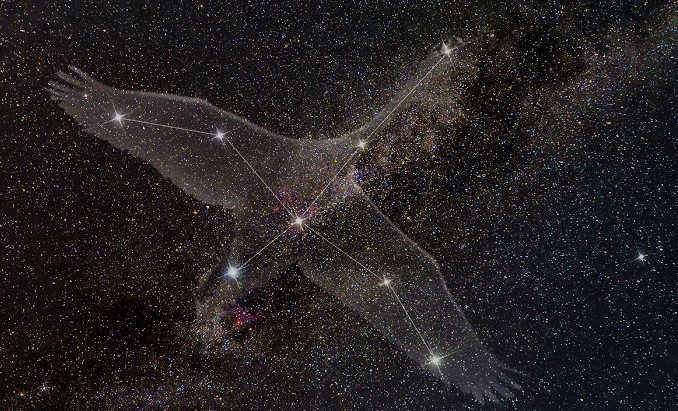
During ancient times, the constellation was linked to a bird soaring through the sky.
Based on one of the ancient Greek myths, the constellation is depicted as Zeus morphed into a swan. In this form, he pursued the stunning Leda, who was the wife of the king of Sparta.
Another variation suggests that the constellation represents Orpheus, positioned in the sky near Lyra.

Constellation of the Swan’s Stars
The main star is Alpha Deneb. It represents a blue-white supergiant. Interestingly, this star is one of the most well-known luminaries. In fact, its absolute magnitude is -7, making it a prototype for the variable stars in the Swan constellation.
Beta is a binary star known as Albireo..
Gamma is an F8 spectral supergiant called Sadr.
Epsilon includes Genach and Eta, which are orange giants. Zeta, on the other hand, is a yellow giant of the G8III class.
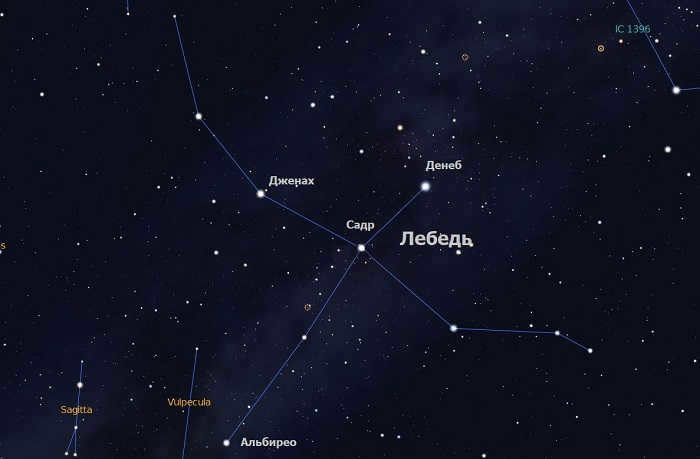
Delta is represented by a triple star. Scientists anticipate that Polaris will assume this role within the constellation in the year 11250.
Tau and 61 Swan are binary stars, while Kappa is a regular giant.
Pi consists of two star systems, while Omega is a Ruhba. which houses two twin giants.
Furthermore, there is a P star in the Swan constellation. It is a blue hypergiant of the variable type. Additionally, there is a main-sequence star named Theta.
Moreover, it is noteworthy to mention the 39th star, which has an orange color, and the Gliese 777. which is a yellow subgiant.
Celestial entities in the constellation Cygnus
When observing the celestial sphere in the northern hemisphere, one cannot miss the sight of a cluster of stars that come together to form an unmistakable cross-like pattern. This renowned asterism, known as the Northern Cross, serves as the defining characteristic of the entire Cygnus constellation.
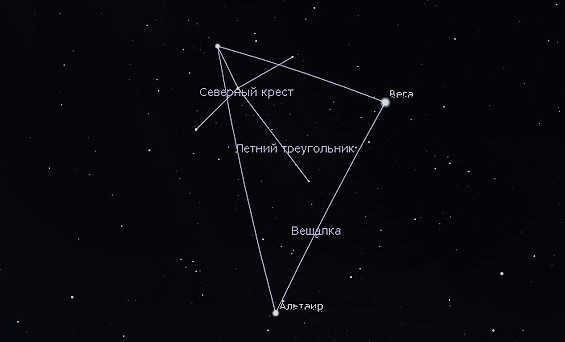
The main stars of the region, including Alpha, Beta, Gamma, Delta, and Epsilon, are concentrated here.
In addition, numerous nebulae have been discovered in this area:
- North America,
- Pelican,
- Crescent Moon,
- the Witch’s Broom,
- the Veil,
- the Shimmering Nebula,
- the dark Coal Sack.
Furthermore, there are meteor streams in this region, such as the October Cygnids and Kappa Cygnids (a weak meteor stream).
It is worth noting that notable objects in this area include the radio galaxy Swan A and the galaxy Fireworks. The latter has actually registered the highest number of supernova outbursts.
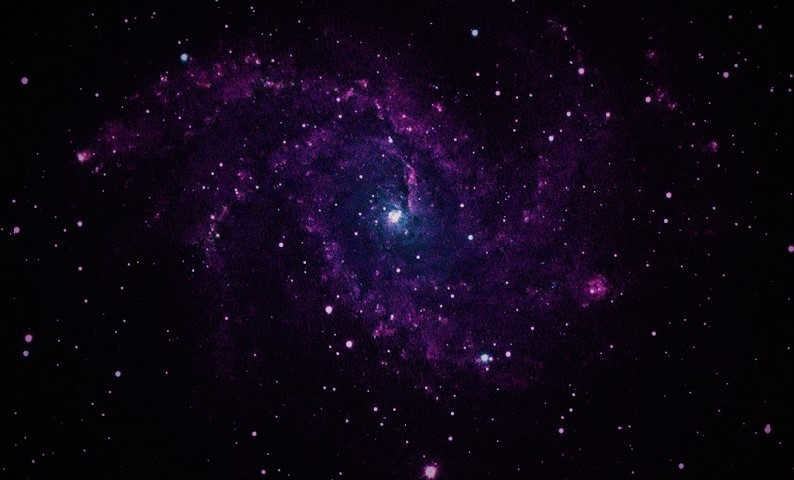
Significantly, Swan encompasses vast regions of stellar formation, such as, Swan X and X-ray sources (Swan X-1). Additionally,
Furthermore, among Messier’s objects, there are M29 and M39. It represents a dispersed cluster of stars.
Simultaneously, there exist sixteen constellations forming triple systems. Alternatively, consider the most luminous star Nova 1975, as well as the variable luminaries P and SS of Swan. Remarkably, Swan even harbors a multitude – Hee which can undergo drastic changes in luminosity.

Observation
Based on astronomical records, the constellation of Cygnus can be seen in the sky at latitudes ranging from +900 to -290. It has been discovered that the optimal time for its visibility is during the summer and early autumn. However, it can still be observed all year round from various locations.
According to an ancient Greek legend, the constellation known as the Swan is linked to the image of Zeus, the god of thunder. The story goes that one day Zeus caught sight of the stunningly beautiful Leda, who happened to be the wife of Tindareus, the king of Sparta. Leda’s divine beauty enchanted Zeus, and he couldn’t help but fall in love with her. However, fearing the wrath of his wife Hera, Zeus transformed himself into a majestic white swan and approached Leda in this form. It wasn’t long before Leda gave birth to two children as a result of her union with Zeus – a daughter named Helen the Beautiful, whose beauty would later spark the infamous Trojan War, and a son named Polydevk (Pollux). Leda also bore two children with her husband Tindareus – a daughter named Clymnestra and a son named Castor. As a testament to their brotherly love, the gods immortalized Castor and Polydeucus in the night sky as the constellation Gemini.
There exists a different tale – regarding the vocalist and instrumentalist Orpheus and his cherished Eurydice, who met a sudden demise due to a venomous serpent’s bite. Incapable of enduring the estrangement, Orpheus pursued her into the domain of the deceased. As a token of his affection for Eurydice, the deities bestowed upon him the celestial form of a swan, positioned close to Lyra.
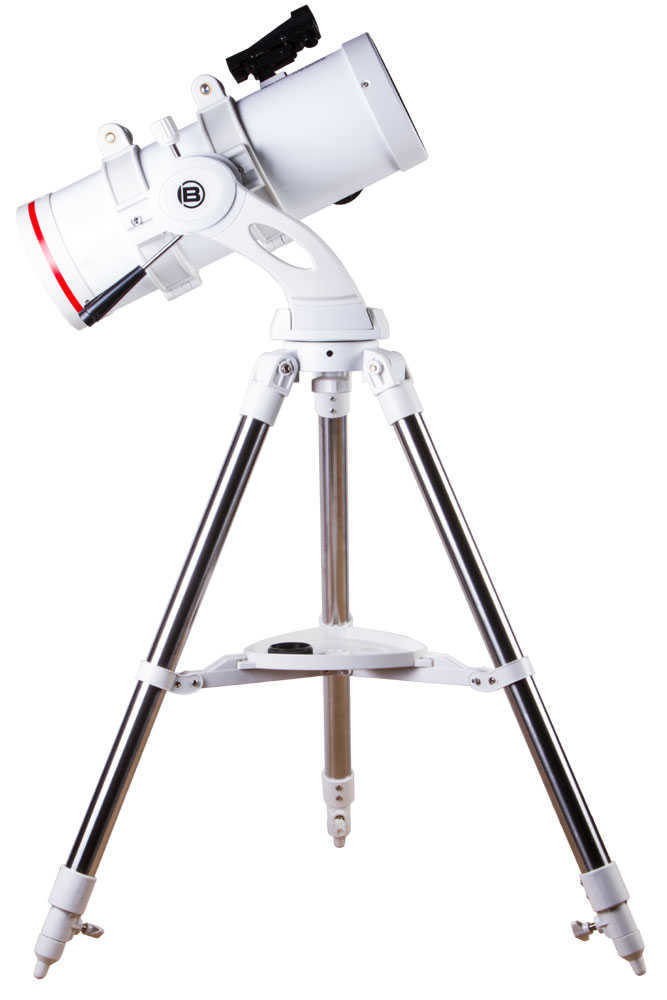
Swan constellation in the sky
The sky harbors a multitude of fascinating objects for astronomers to explore within the Swan constellation. Among these treasures is a brilliant white supergiant known as Deneb, whose luminosity surpasses that of the sun by a staggering 67,000 times! Deneb serves as the focal point of the Swan constellation and is highly recommended for in-depth study. Another noteworthy star within this constellation is Albireo, a binary system composed of an orange giant and a smaller, less luminous blue star. This captivating duo is easily observable through a telescope.
Furthermore, the Swan constellation boasts an array of captivating astronomical objects, including nebulae from the NGC catalog, X-ray sources, star systems, and countless other celestial wonders waiting to be discovered.
There is a popular belief in Chinese mythology that revolves around the Swan constellation. As the constellation intersects with the Milky Way, it is said to act as a ford or bridge over the celestial river.
Our article provides a brief overview of the Swan constellation. For more detailed information, you can refer to two additional articles available on our website. They can be found at the following links – the first and the second, respectively. Additionally, our team of consultants is available to assist you in selecting the appropriate optical instrument for your observations. Feel free to give us a call or send us a message!
Please note that the manufacturer reserves the right to modify prices, the model range, technical specifications, or discontinue the production of any product without prior notice.

More telescope and astronomy reviews and articles:
Reviews of optical equipment and accessories:
Guides on telescopes. Tips for selecting, assembling, and conducting initial observations:

The enigmatic cluster Swan is a pattern of stars located in the celestial sphere of the night sky, alternatively known as the Northern Cross. Luminous celestial bodies create a distinct cross-like structure that extends across the Milky Way, resembling the Swan extending its wings and ascending above the planet. The Swan has a rich history as one of the oldest constellations. In ancient depictions of the cluster, the swan soars with its wings outstretched and its neck elongated, seemingly guiding us along the path.
Mythology abounds with tales linked to the Swan cluster.
The Swan is linked to mythical and perhaps non-mythical figures – Aphrodite, Apollo, Zeus, Leda, Orpheus, Brahma, and Saraswati – in the myths of various countries around the world. One well-known myth involves Zeus transforming into a Swan to seduce Leda with his beauty. Descending from the heavens in this form, he conquered her and then ascended back into the sky. Thus, for centuries, he gazes upon his beloved from the heights above.
There is another legend that recounts the story of the enchanting Orpheus and his adored Eurydice. This captivating singer from Thrace is symbolized in the Swan constellation, accompanied by the Lyra constellation. Orpheus, likewise, is a somewhat enigmatic mythical character. It is highly likely that he hails from the people of the northern regions. Despite the saying that all roads lead to Rome, I am increasingly convinced that the origins and progress of civilizations trace back to the North. However, that is not the focus of my discussion at present.
There exists an alternative version of the tale regarding the constellation of the Swan, which is not as widely known, but still holds significance. The constellation Lyra represents the celestial lyre once owned by the deity Apollo, which he left behind in the heavens. According to Greek chroniclers, Apollo would journey back to his homeland, Hyperborea, every other year.
The swan serves as a prominent symbol of Hyperborea. The symbolism of the Hyperborean swan extended across the northern regions of Europe and even reached deep into the Eurasian continent.
Interestingly, this constellation is also referred to as the Northern Cross.
Why was this constellation associated with the cross, and even with the crucifixion of Jesus?
Once upon a time, a brilliant star appeared in the Swan constellation, surpassing the brightness of both the sun and the other stars, illuminating the night sky as bright as day. It continued to burn for several days, never descending below the horizon due to the constellation’s position in the north.
Today, this star remains unseen to the naked eye. It is known as the Swan Sun, emitting its radiance in a different spectrum, invisible to human perception. However, in late August 1975, an unidentified star once again illuminated the Swan constellation, shining even brighter than the prominent star Deneb for a few days before gradually fading away.
The enigmatic Swan constellation captivates not only scientists but also esotericists and religious figures, drawing their attention and fascination.
There are various reports circulating stating that on the morning of December 21, 2012, the Sun will align with the Great Divide of the Milky Way in the Constellation Swan, positioning itself visually in the center of our galaxy. This alignment is believed to mark the Zero Point of a new Time Wave, which will play a significant role in the future evolution of humanity.
This particular star has been associated with the figure of Christ on the Cross.
If we examine paintings depicting the crucifixion of Christ alongside images of the Swan constellation, we can observe striking similarities. Both feature a central cross with Christ crucified, flanked by two robbers on crosses. The resemblance between the two is uncanny.
In ancient times, the constellation of the Swan was also associated with Irij – the location of Paradise, the world’s paradise tree. In the ancient Vedas, Irij is represented as the Sun.
Over 15,000 years ago, Polaris was known as the star Deneb in the Swan constellation. It was during this time that people began to understand the astronomical nature of the World Tree (Iriyum, Paradise). It is unclear what our ancestors had in mind when they referred to this constellation as Heaven’s Gate, but the Swan constellation was revered as the most powerful divine source.
The concept of the swan in ancient Slavic legends is connected with the original egg and the bird that created the world. Swan symbolism is deeply ingrained in the history of the Eurasian peoples. Evidence of reverence and adoration for the swan can be found in the Middle Urals, as well as in the rock art of the White Sea and Onega Lake. Some followers of esoteric beliefs suggest that our earliest ancestors, the Sva-ga clans – the blue-eyed Svyatoruses, came from the Swan Constellation, also known as Swan’s Chertog (Makosh or the Bucket of the Big Dipper).
And what is the value of the warlike Germanic Valkyries with swan wings adorning their helmets and their knight Lohengrin, who is also associated with swans. These remarkable Valkyries, who are often depicted as swan maidens in legends, are known to frequently visit the river, shed their swan feathers, and immerse themselves in the icy waters.
The ancient Slavs have a legend about the Swan Maiden, who was the ancestor of their clans after a courageous young man stole her feathers. The Cult of the Swan was a significant aspect of the early Christian period.
The Swan Maiden (Leda, Lada) is a timeless and all-encompassing representation. Discussing it in its entirety would require more than just this article, as the image has been intentionally distorted and transformed into a more aggressive and unattractive form in the legends of ancient Greece (Medusa Gorgon). The motif of transformation into a swan is prevalent in many cultures, with myths often mentioning the union between humans and swans.
In the northern countries, flying swans frequently became symbols or were depicted on coats of arms. For instance, the coat of arms of the town of Kurkkiyoki (Karelia) features a swan.
When Britain assumed the presidency of the European Union in 2005, it chose a flock of flying swans in a wedge formation as its symbol. This symbol was intended to signify a peaceful transition of leadership within the union.
Swans have taken on various symbolic roles throughout different cultures and traditions. They are often seen as a representation of morality, respect for tradition, the pursuit of purity, and the development of intelligence.
In Christianity, the White Swan is associated with purity, mercy, and is considered a symbol of the Virgin Mary.
The Evenks, a Siberian indigenous group, believe that the swan is the leader of a flock of birds and carries the soul of the Shaman.
In Chinese culture, the swan is viewed as a solar bird and symbolizes the male Yang energy.
Among the Celts, swans are considered solar deities who bring good fortune and have the ability to heal people with the energy of the Sun and water.
In ancient India, there is a pair of Swans known as Ham and Sa (Saraswati). They only consume the honey of the blossoming lotus of knowledge and reside in the Supreme realm.
Additionally, in ancient India, Brahma, the creator god, is depicted riding on a Swan.
Therefore, the White Swan represents the Spirit and untainted human Soul. The constellation Swan serves as a cosmic projection of this powerful legendary bird.
There are several celestial objects that can be observed, including the Swan X-1, the prominent stars Albireo and Deneb, the NGC 6946 Fireworks Galaxy, and a number of famous nebulae such as the Pelican (IC 5070), North America (NGC 7000), Crescent (NGC 6888), and Veil (NGC 6960, 6962, 6979, 6992, and 6995).

Facts, location, and map
The Swan constellation, also known as Cygnus, covers an area of 804 square degrees, making it the 16th largest constellation. It can be found in the fourth quadrant of the northern hemisphere (NQ4) and is visible at latitudes ranging from +90° to -40°. Cygnus shares its borders with the Dragon, Lyra, Pegasus, Vulpecula, Lacerta, and Cepheus constellations.
Cygnus is home to 10 stars known to have planets and two Messier objects, Messier 29 (NGC 6913) and Messier 39 (NGC 7092). The brightest star in Cygnus is Deneb, which ranks 19th in the night sky with an apparent magnitude of 1.25. Additionally, Cygnus is associated with two meteor streams, the October Cygnids and the Kappa Cygnids. Refer to the star map below to locate the Swan constellation.


The constellation is associated with various legends. The most popular one is about Leda, the queen of Sparta, who gave birth to two immortal twins, Pollux and Helen, as well as two mortal children, Castor and Clytemnestra. Leda was seduced by Zeus, who transformed himself into a swan.
Another myth involves Orpheus, who is sometimes depicted as a swan. This Greek hero was killed by Thracian Maenads because he refused to worship Dionysus. After his death, he became a swan and found his place in the sky alongside Lyra.
Main celestial bodies
The primary celestial bodies that make up the Northern Cross constellation are Deneb, Delta Swan, Albireo, Epsilon Swan, and Gamma Swan.
Deneb, also known as Alpha Swan, is a blue-white supergiant (A2 Ia) located approximately 1400 light-years away. It has an apparent magnitude of 1.25, making it the brightest star in the constellation and the 19th brightest star in the sky overall.
Deneb serves as a representative example of the Alpha Swan variable star class. Its brightness and spectral type exhibit slight variations due to surface fluctuations that are not radial in nature. Additionally, Deneb has exhausted its hydrogen fusion in the core, indicating that it will eventually undergo a supernova explosion within the next several million years.
With an absolute magnitude of -7.0, it is one of the most well-known luminous stars. It shines almost 60000 times brighter than the Sun and has a mass that is about 20 times that of the Sun. This star holds the title for being the farthest star visible with a magnitude of 1. It is also renowned for being a white star. Interestingly, on Mars, Deneb appears as the north pole star.
Sadr, also known as Gamma Swan, is classified as a supergiant star of spectral class F8. It is located at a distance of 1800 light years from Earth. With an apparent magnitude of 2.23, Sadr is among the brightest stars that can be observed in the night sky. It is 12 times more massive than the Sun, which means it consumes its nuclear fuel at a faster rate. This star is estimated to be around 12 million years old.

The IC 1318 emission nebula is located in the sky.
Jenach, also known as Epsilon of the Swan, is a K0 III orange giant. It has an apparent visual magnitude of 2.480 and is located 72.7 light-years away. This star has a brightness 62 times that of the Sun and a radius 11 times larger. It has a companion with a magnitude of 13.
The constellation is represented by two close stars and one distant star. The brightest star is a blue-white giant (B9 III) in the main sequence, nearing the end of its life. It is a fast-spinning star with an equatorial velocity of at least 135 km/s.
The closest companion to the brightest star is a yellow-white star (F1 V) with an apparent magnitude of 6.33. The third companion is an orange giant with a magnitude of 12.

Albireo is composed of a primary yellow star with a visible magnitude of 3.18, which forms a close binary system with a secondary blue companion star with a visible magnitude of 5.82. The two stars are separated by a distance of 35 arc seconds. Due to this distinct contrast between the colors of the stars, Albireo is a popular target for amateur astronomers.
Albireo A is comprised of two stars that are separated by 9.4 seconds of arc, making it difficult to observe with a telescope smaller than 20 inches. The primary star has a spectral class of K3III.
On the other hand, Albireo B is a rapidly rotating Be star with a spectral type of B0V, which means it rotates at a speed of 250 km/s.
Zeta Swan is an astronomical object that can be classified as a yellow star of spectral class G8III. It is located at a distance of 151 light-years from us. The star has an apparent magnitude of 3.20, which means it is visible to the naked eye. In terms of size, Zeta Swan is about 14.7 times larger than our Sun, and it is also much brighter, with a luminosity that is 119 times greater.
One interesting characteristic of Zeta Swan is that it is considered a giant star, meaning it has gone through a phase of helium fusion in its core. This process is responsible for the star’s increased size and brightness. Additionally, Zeta Swan has a companion star, which is a white dwarf. This companion has a magnitude of 12, making it much fainter than Zeta Swan.
Another double star system worth mentioning is Tau Swan. This system consists of two stars: a yellowish-white subgiant named GJ 822.1 A (F2IV) and a yellow main-sequence star called GJ 822.1 B (G0V). The second star in this system is similar to our Sun in terms of size, luminosity, and surface temperature. The visible magnitudes of these stars are 3.84 and 6.44, respectively. Tau Swan is located 68.2 light-years away from us.
To summarize, both Zeta Swan and Tau Swan are interesting binary star systems that offer valuable insights into stellar evolution and the diversity of stars in our universe.
Swan Cap is a massive star classified as a G9 III spectral type. It has a visible magnitude of 3.814 and is situated at a distance of 124.2 light-years. This star is positioned at the tip of the left wing of the constellation and can be observed with the naked eye. The Kappa Cignida meteor shower, which occurs annually in August, is associated with Swan Cap and appears 5 degrees north of it. This meteor shower is relatively small in size.
Another Swan, known as an orange giant (K0III), is located 139 light-years away. It has a visible magnitude of 3.909.
There is also a star system called 61 Swan, which consists of two dwarf stars with spectral types K5V and K7V. These stars orbit around each other every 659 years. Their visible magnitudes are 5.21 and 6.03. The system is located 11.41 light-years away from us, making it the 15th closest system.
It is characterized by proper motion – a change in position over time, observed from the center of mass of the system. The Flying Star, as it was originally named by Italian astronomer and mathematician Giuseppe Piazzi in 1804, is known for its unique movement.
What sets 61 The Swan apart is that it is the first star (aside from the Sun) to have its distance measured from Earth. German astronomer Friedrich Wilhelm Bessel accomplished this using the parallax method, which involves calculating the displacement of a star’s apparent position when observed from two different angles. The star’s peculiar motion made it an ideal candidate for such calculations.


61 Swan is classified as a Bessel star.
P Swan (34 Swan) is an exceptionally bright variable hypergiant with a blue hue, belonging to the spectral class B1Ia +. It is situated approximately 6,000 light-years away from Earth. This star stands out as one of the most luminous objects within the Milky Way galaxy. Luminous blue variables are relatively uncommon and are typically found in regions characterized by vigorous star formation. These stars have relatively short lifespans due to their immense mass and high energy output, depleting their nuclear fuel rapidly and eventually culminating in supernova explosions within a few million years. In contrast, our own Sun has been shining for billions of years.
Johann Bayer identified the star P as a nova. It is often called a permanent nova due to its significant changes in brightness.
39 Swan is classified as an orange star (K3III) with a visible magnitude of 4.436 and is located 260 light-years away. It is cooler than the Sun but much brighter and larger. Its surface temperature ranges between 3500-5000 Kelvin.
Theta Swan is categorized as a main-sequence star (F3 V) situated at a distance of 59.8 light-years from our solar system. It has an apparent visual magnitude of 4.490, making it four times brighter than the Sun and 38% larger in mass. It is estimated to be around 0.6-1.9 billion years old. This star has a faint companion, a red dwarf (M3 V) with a magnitude of 13.03, located 3 angular seconds away.
The star is fascinating because it has the potential to host an exoplanet. The ELODIE team has observed variations in the radial velocity, indicating that there may be a planet with a period of less than six months orbiting around it. This potential planet is estimated to be twice the size of Jupiter, but further confirmation is still needed.
16 Swans is a remarkable triple star system. It consists of two sun-like yellow dwarfs with apparent magnitudes of 5.96 and 6.20. The third star in the system is a red dwarf. This system is located approximately 70 light-years away. Interestingly, a planet has been observed in an eccentric orbit around the second star.
Gliese 777 (HD 190360) is a yellow subgiant (G6IV) situated 51.81 light-years away. It has an apparent magnitude of 5.71. In 2005, two exoplanets were discovered within this system. Additionally, there is a companion in the form of a dim red dwarf (M4.5V), which is located at a distance of 3000 astronomical units. The visual magnitude of this companion is 14.40, and it may also be a binary star system.
Heavenly bodies
Messier 29 (M29, NGC 6913) is a cluster that is visible with an apparent visual magnitude of 7.1. It is located 4000 light-years away, making it detectable with binoculars. Charles Messier discovered it in 1764 near the star Gamma Swan (1.7 degrees south and slightly east).
The cluster is estimated to be 10 million years old. The brightest star within it has a visual magnitude of 8.59. The five hottest stars in the cluster are classified as spectral class B0.

Messier 39 (M39, NGC 7092) was discovered by Charles Messier in 1764. It is a star cluster with an apparent visual magnitude of 5.5. The brightest star in the cluster is classified as A0 and has a visual magnitude of 6.83. All the stars in the cluster are part of the main sequence, and the brightest ones will eventually evolve into red giants.
The age of Messier 39 is estimated to be between 200 and 300 million years, which is considered an intermediate age for an open cluster. It is located 800 light-years away from our solar system and can be found 2.5 degrees west and south of the star Pi-2 Swan.

The Fireworks Galaxy (NGC 6946, Arp 29, Caldwell 12) is an intermediate spiral galaxy that has an apparent visual magnitude of 9.6. It can be found approximately 22.5 million light-years away in the vicinity of the constellation Cepheus. Due to its proximity to the galactic plane, it is partially obscured by the interstellar material of the Milky Way.
Frederick William Herschel discovered it on September 9, 1798. Since then, ten supernovae have been observed within the galaxy: SN 1917A, SN 1939C, SN 1948B, SN 1968D, SN 1969P, SN 1980K, SN 2002hh, SN 2004et, and SN 2008S.

The Swan X-1 is a well-known source of X-rays, which was discovered during a rocket flight in 1964. It was the first candidate for a black hole and has a mass 8.7 times that of the sun. Due to its extreme compactness at this mass, it is believed to be a black hole. It is located 6100 light-years away from us.
This celestial object orbits the blue variable star HDE 226868, forming a binary system. Over time, an accretion disk of material, created by the stellar wind, has formed around the Swan X-1.
The North America Nebula (NGC 7000, Caldwell 20) is an emission nebula with a visual magnitude of 4 and is located at a distance of 1600 light-years. It received its name because its shape resembles the continent of North America, caused by the overlapping of a dusty band with the object.
With its dimensions of 120 by 100 angular minutes, the nebula is classified as a large one. However, its low surface brightness usually makes it difficult to observe without the aid of binoculars.

NGC 7000, also known as the North America Nebula, was first discovered by William Herschel on October 24, 1786. The nebula contains a high concentration of star formation, particularly in the region known as the Swan Wall, which corresponds to the location of Mexico and Central America. This nebula is classified as an H II region, which is an interstellar cloud where stars are born. It is closely associated with another nebula called the Pelican Nebula (IC 5070).
The Pelican Nebula (IC 5070 and IC 5067) is an emission nebula located 1800 light-years away. It is named after the bird it resembles and has an apparent visual magnitude of 8.0.
You can find the Pelican Nebula by heading northeast from the prominent star Deneb.

Pelican Nebula – IC 5070
The Sadr Region (IC 1318) is a glowing cloud of gas and dust formed around the star Sadr (Gamma Swan), which is situated at the intersection of the Northern Cross.
The Crescent Nebula (NGC 6888, Caldwell 27) is an emission nebula produced by the powerful winds of the Wolf-Rayet star HD 192163 (WR 136), an aging massive star that is rapidly shedding mass. Approximately 400,000 years ago, it transformed into a red giant and shaped the nebula with its influence. The Crescent Nebula measures 18′ x 12′ and has an apparent magnitude of 7.4. It is located 5,000 light years away.

NGC 6888, also known as the Crescent Nebula, is an emission nebula that is part of the Swan Loop. This large supernova remnant covers an area of 3 degrees in the sky and is a notable source of soft X-ray emission. In addition to its visual representation, the Swan Loop can be observed in radio, infrared, and X-ray images, with the Veil Nebula being one of its prominent features. The Veil Nebula consists of several parts, including the Western Veil (NGC 6960), the Eastern Veil (NGC 6992, NGC 6995, IC 1340), and the Fleming Triangle (Pickering Triangle).


The Veil Nebula is created by combining several color photographs.
Located in the western part of the nebula, NGC 6960 forms the largest section known as the Western Veil or the Witch’s Broom.
The Eastern Veil consists of three bright regions: NGC 6996, NGC 6995, and IC 1340.
Pickering’s Triangle, also known as Pickering’s Triangle Beam, was discovered in 1904 by American astronomer William Fleming while he was working at Harvard Observatory. It was named in honor of the observatory’s director, Edward Pickering.
NGC 6974 and NGC 6979 are regions located on the northern edge of the nebula. NGC 6979 was discovered by William Herschel, while NGC 6974 was discovered by William Parsons.
The Swan Loop covers a distance of 90 light-years and is located 1470 light-years away. The age of the supernova remnant is estimated to be between 5000 and 8000 years.
If you want to explore the Swan constellation in the northern hemisphere in more detail, you can utilize not only our photographs but also 3D models and an online telescope. To aid in your own search, a star map will be helpful.
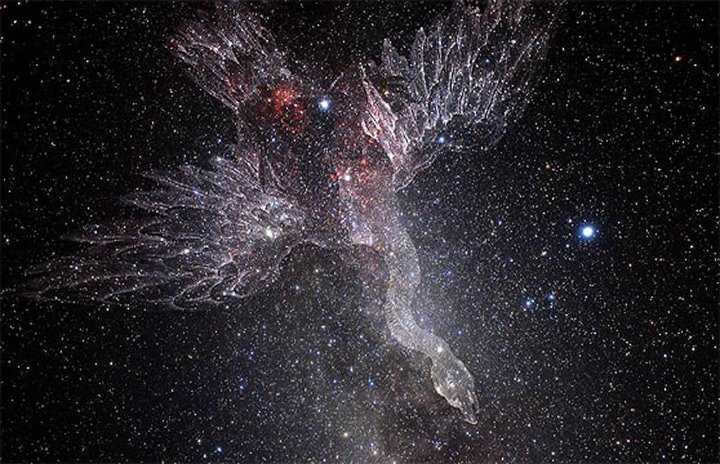
- Stars Groupings
The constellation of Swan is located in the northern hemisphere of the night sky. It is characterized by a cross-shaped pattern made up of bright stars, known as the Northern Cross. This pattern stretches along the Milky Way and has been associated with flying birds by ancient civilizations. The Babylonians referred to it as the “forest bird”, while the Arabs called it the “chicken”.
In Russia’s middle latitudes, the Swan constellation can be observed throughout the year, but the best viewing conditions are during the summer and early fall.
| Scientific Name | Cygnus (gen. Cygni) |
| Brightest stars (magnitude < 3 m ) | Deneb (α Cyg) – 1.25 m |
Legend

How did the Swan, which has such a strong connection to water, manage to ascend to the sky and become a part of the constellations? The answer lies within the mythology that intertwines the constellations of Swan and Lyra.
In ancient times, the renowned Spartan hero Tyndareus was exiled from his own kingdom by his brother Hippokontes. He spent many years wandering, journeying through numerous lands, yet finding no refuge. Eventually, he arrived in Aetolia and sought refuge with king Testius, who not only welcomed him as an esteemed guest but also formed a deep bond with him, ultimately offering his divine-like daughter Leda as a wife.
Tyndareus lived happily, and after a while, Hercules slew Hippokontes and his sons, allowing Tyndareus to return to his homeland of Sparta alongside Leda.
Leda’s incredible beauty and enchantment captivated all who laid eyes upon her. Word spread throughout Greece that she possessed the same beauty as the immortal goddesses. Could such a mesmerizing beauty go unnoticed by Zeus? One fateful day, Zeus caught sight of her and immediately devised a plan to possess Leda without arousing the suspicions of his jealous wife Hera. He transformed into a pure white swan and gracefully descended from the heights of Mount Olympus to Sparta, where Leda resided.
Every night, Leda welcomed the Swan, who was none other than the all-powerful Zeus himself. From their encounters, Leda bore two extraordinary children – a daughter named Helen, who possessed the same breathtaking beauty as a goddess and later became the catalyst for the Trojan War, and a son named Polydevk, a renowned hero bestowed with immortality by Zeus.
Two children were born to Leda, daughter Clytemnestra and son Castor, from Tyndareus as well.
The constellation of the Swan in the sky symbolizes Zeus, who transforms into a beautiful white bird and descends to Earth to be with his beloved Leda.
The primary stars in the Swan constellation
The asterism known as the Northern Cross is comprised of five stars: Deneb, Delta Swan, Albireo, Epsilon Swan, and Gamma Swan.
Deneb is a star in the constellation Cygnus.
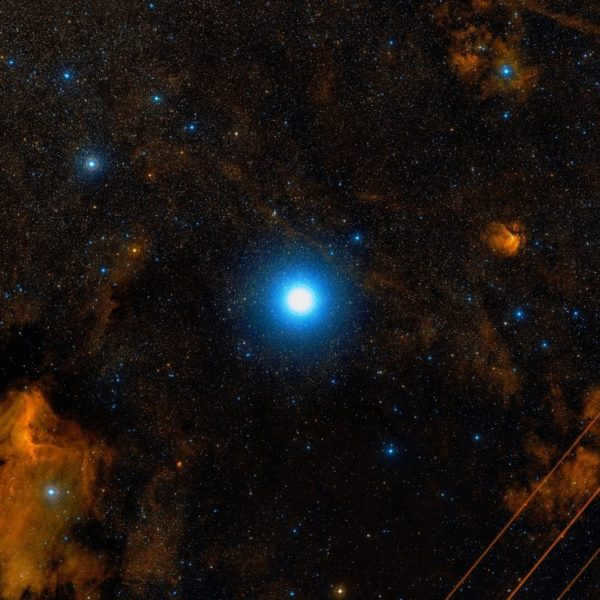
Alpha Swan is a supergiant star known for its blue-white color. It is located 1,400 light-years away from Earth. With an apparent magnitude of 1.25, it is the brightest star in its constellation and the 19th brightest star in the sky.
This star serves as a prototype for the Alpha Swan class of variable stars. Its brightness and spectral type vary slightly due to fluctuations on its surface that are not radial in nature. Alpha Swan has already stopped fusing hydrogen in its core, which means it will eventually explode as a supernova in the next few million years.
Alpha Swan is one of the most well-known luminous stars, with an absolute magnitude of -7.0. It is nearly 60,000 times brighter than the sun and has a mass that is about 20 times greater. This star is also notable for being the most distant star with an apparent magnitude of 1. Additionally, Alpha Swan is famous for being one of the brightest white stars. It is even used as the north pole star on Mars, where it is known as Dhaneb.
The term “dhaneb” is derived from Arabic and means “tail” (specifically, the tail of a chicken). In Chinese mythology, the star symbolizes a bridge or fairy and is associated with the myth of the “Bridge of Forty”. When combined with Altair (the Eagle) and Vega (Lyra), it forms the asterism known as the “Summer-Fall Triangle”.
Gamma Swan, a supergiant star of spectral class F8, is situated 1800 light-years away. With a visible magnitude of 2.23, it is one of the most prominent stars observable in the nighttime sky. Boasting a mass 12 times that of the Sun, this star burns through its nuclear fuel at an accelerated rate. It has an age of 12 million years.
Surrounding Gamma Swan is the diffuse emission nebula IC 1318. Positioned at the crossing point of the Northern Cross, this star derives its name from the Arabic word “Sadr,” which translates to “chest.” Additionally, it is known by its Latin name, “Pectus Gallinae,” which signifies “chicken chest.”
Jenach
Epsilon of the Swan is a K0 III spectral type orange giant star. It has an apparent visual magnitude of 2.480 and is located approximately 72.7 light-years away. The star is 62 times brighter than the Sun and has a radius 11 times larger. It has a companion with a magnitude of 13. Jenah shares its name with Gamma Raven, a star in the constellation Raven, and the word “Jenah” translates from Arabic as “wing”.
Located in the constellation of Cygnus, there is a remarkable triple star system known as Swan. With a combined apparent visual magnitude of 2.87 and a distance of 165 light-years, this celestial formation is truly awe-inspiring. Interestingly, around the year 11250, Swan is predicted to transform into the illustrious Polaris.
Swan consists of three stars, each playing a unique role in this cosmic dance. The dominant star is a dazzling blue-white giant (B9 III) that resides on the main sequence, steadily approaching the final stage of its life cycle. Notably, this star spins rapidly, boasting an equatorial velocity of at least 135 km/s.
Nestled closely to the primary star is a companion star, shining with a yellow-white hue (F1 V) and boasting an apparent magnitude of 6.33. This star adds depth and complexity to the Swan system. Additionally, there is a third companion star, an orange giant with a magnitude of 12th, further enhancing the stellar tapestry that is Swan.
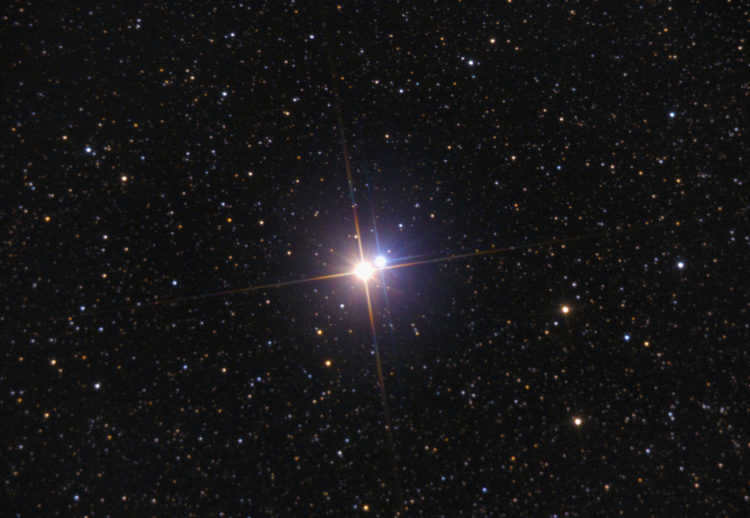
Beta Swan is a binary star system that can be observed with a small telescope. It is situated at a distance of 380 light-years. In terms of brightness, it holds the 5th position in the constellation. It can be found in the head of the Swan and is sometimes referred to as the “beak star”. It is also a part of the Northern Cross.
Albireo is composed of a yellow star with a visible magnitude of 3.18, which forms a close binary system with a faint blue companion having a visible magnitude of 5.82. They are separated by 35 arc seconds. Due to this striking contrast, the star system is a popular target for amateur astronomers.
- Albireo A consists of two stars that are separated by 9.4 seconds (they cannot be resolved in a telescope smaller than 20 inches). The spectral class of Albireo A is K3III.
- Albireo B is a rapidly rotating Be star (with a velocity of 250 km/s) of spectral type B0V.
Located 151 light-years away, there is a yellow star of spectral class G8III. With an apparent magnitude of 3.20, it shines brightly in the night sky. This star is much larger than our Sun, with a radius that is 14.7 times greater. Not only is it bigger, but it is also much brighter, shining 119 times more intensely. Scientists classify this star as a giant due to its size and the presence of helium fusion in its core.
Interestingly, this star has a nearby companion—a white dwarf with a magnitude of 12. Together, they form a binary system. The white dwarf, known as CCDM star J21129 + 3014B, adds to the intrigue and complexity of this celestial arrangement.
The double star known as GJ 822.1 consists of two stars, GJ 822.1 A and GJ 822.1 B. GJ 822.1 A is a subgiant star, specifically a yellowish-white subgiant of spectral type F2IV. GJ 822.1 B, on the other hand, is a yellow main-sequence star of spectral type G0V. Both stars are similar to the Sun in terms of size, luminosity, and surface temperature. The visible magnitudes of GJ 822.1 A and GJ 822.1 B are 3.84 and 6.44, respectively. This double star system is located approximately 68.2 light-years away from our own solar system.
A colossal star classified as G9 III, boasting a visible magnitude of 3.814, and situated 124.2 light-years away. Positioned at the extremity of the left wing of its constellation, it is observable to the naked eye. Accompanying this celestial body is the Kappa Cignida meteor shower, which manifests itself 5 degrees to the north. A modest meteor shower, it can be witnessed annually in the month of August.
There are two star systems that represent it. Pi 1 Swan is a B3IV spectral type star with a visual magnitude of 4.67 and a distance from us of 1,680 light-years. The name Azelfage comes from the Arabic phrase al thīlf al faras ‘horse trail’ or from al’azal al-dajājah ‘chicken tail’.
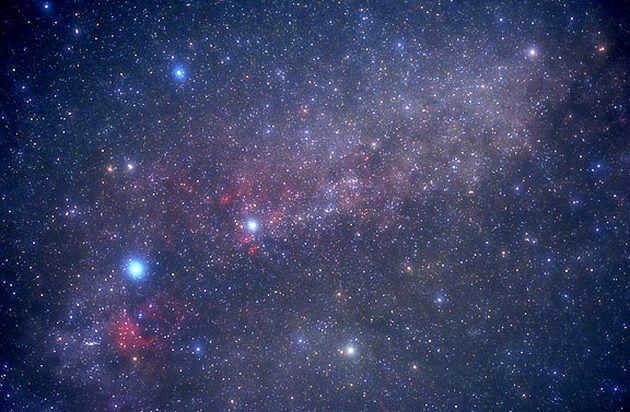
34 Swan is an astonishing blue hypergiant star with a variable spectrum classified as B1Ia +. Its distance from Earth is approximately 6,000 light-years. This stellar beauty shines brilliantly in the Milky Way, captivating astronomers with its luminosity. Luminous blue variables, like 34 Swan, are a rarity and can only be found in regions of intense star formation. However, their existence is short-lived due to their immense mass and energy. They rapidly deplete their nuclear fuel and ultimately evolve into supernovae within a few million years. In comparison, our Sun has been radiating its warmth for billions of years.
Johann Bayer classified the star P as a nova, which is sometimes referred to as a permanent nova due to its significant fluctuations in brightness.
Theta Swan
Theta Swan is a main-sequence star (F3 V) located 59.8 light-years away from our solar system. It has an apparent visual magnitude of 4.490, making it four times brighter than the Sun, and it also has a mass that is 38% larger. The star is estimated to be 0.6-1.9 billion years old and has a companion, a red dwarf (M3 V), which has a magnitude of 13.03 and is located 3 arc seconds away.
This star is particularly intriguing because it has the potential to host an extrasolar planet. The ELODIE team has observed variations in the star’s radial velocity, indicating the presence of an object orbiting it with a period of less than six months. Although the planet is believed to be twice the size of Jupiter, its existence has not yet been confirmed.
A triple star system. The two brighter stars are similar to our Sun, with apparent magnitudes of 5.96 and 6.20. The third star is a smaller red dwarf. This star system is situated 70 light-years from Earth. Astronomers have discovered a planet in the unusual orbit of the second star.
Known as Gliese 777 or HD 190360, this triple star system offers a fascinating glimpse into the diversity of stellar systems.

An astronomical object known as a yellow subgiant (G6IV) is situated at a distance of 51.81 light-years from Earth. This celestial body has an apparent magnitude of 5.71, making it visible to the naked eye. The system in which it resides was discovered to have two exoplanets in 2005. Additionally, there is also a companion star, classified as a dim red dwarf (M4.5V), which is located 3000 astronomical units away from the yellow subgiant. The visual magnitude of this companion star is measured to be 14.40, suggesting that it may actually be a binary star system.
Rukhba is made up of two optical duplicates that are 1/3 degree apart. The ancient Arabic term Rukhba means “knee of a chicken”. Omega-1 is a high-temperature subgiant (B2.5) with a visual magnitude of 4.95 and is positioned 910 light years away. Omega-2 is a red giant (M2III) with a magnitude of 5.22, situated 400 light-years distant.
Aside from its abundance of prominent stars, the Swan constellation stands out for its remarkable assortment of celestial entities in the far reaches of space. One can find over twenty-five dispersed clusters, numerous emission clusters, and a significant amount of dark nebulae within its borders. To catch a glimpse of these celestial jewels, it is recommended to equip oneself with a pair of high-powered binoculars, such as the 15×70.
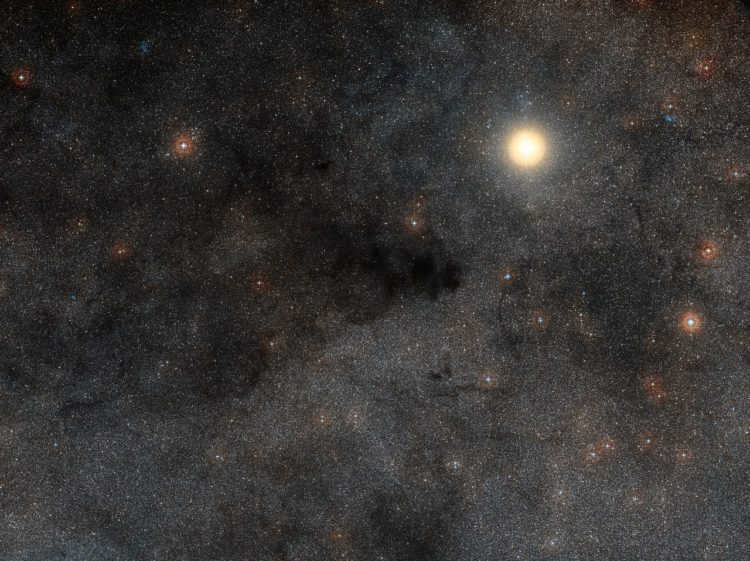
To begin, let’s take a stroll from the Southwestern region of the constellation towards the Northeast. As we do, each of these celestial objects will gradually come into view, one after the other. They will appear to float against the backdrop of the vast scattering of stars in the Milky Way, occasionally revealing darker areas that resemble “pockets”. These pockets are actually dark nebulae, which consist of cold, thinly spread interstellar matter. One of these nebulae can be found a bit south of Deneb and is known as the Northern Coal Sack (similar to the Coal Sack in the Southern Cross constellation).
The Northern Coal Sack is best observed using wide-angle binoculars at lower magnifications, around 5x, or simply with the naked eye under a sufficiently dark and clear sky. In either case, you will be able to perceive a shadowy region of irregular, elongated shape, from which a dark band extends towards the South.
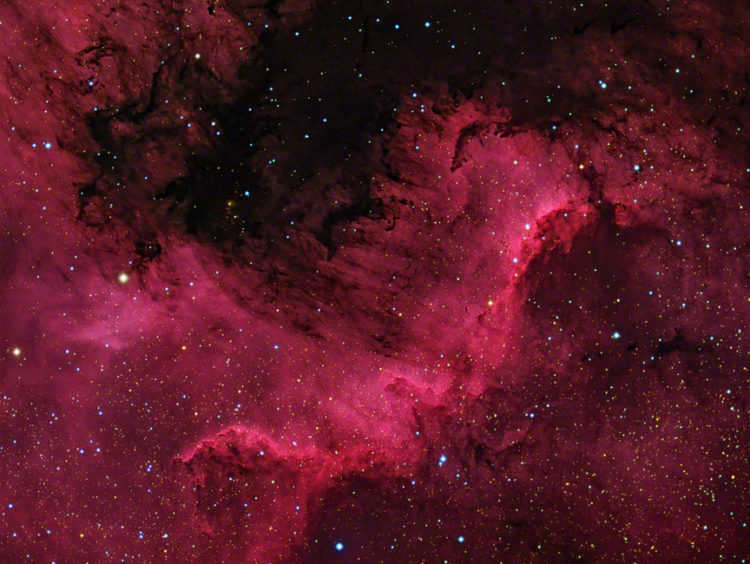
Let’s start our search for the next object by using Deneb as a reference point. Our target is the emission nebula NGC 7000, which is more commonly known as the North America Nebula. It is a relatively bright celestial object.
The nebula has a stellar magnitude of 4.5, but its surface brightness is not particularly high. This is due to the fact that the emission region is quite vast, with the nebula spanning over 2.5 degrees. As a result, it may be challenging to locate the North America Nebula on your first attempt. Additionally, its contrast with the luminous star clouds of the Milky Way is relatively low.
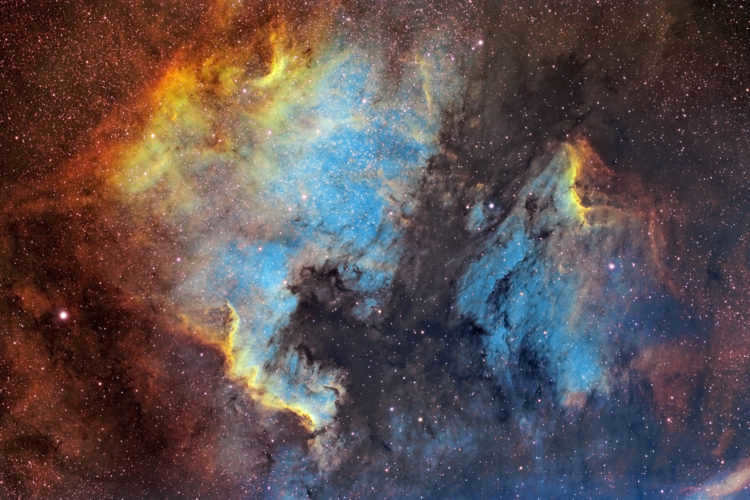
When you observe the night sky in a rural or suburban area, you can easily spot a faint glow located about three degrees east of Deneb. However, when you use binoculars to focus on the exact spot where the glow is visible to the naked eye, it becomes more difficult to see as it blends into the Milky Way. To locate NGC 7000 using binoculars, it is actually easier to orient yourself not towards the glow, but towards the dark area that resembles the “Gulf of Mexico” in the celestial “continent”. Once you locate this “bay”, it will be much simpler to identify the distinct shape of the nebula.
Pelican Nebula
Adjacent to the “Gulf of Mexico,” there exists an additional nebulous formation known as the Pelican Nebula. Although they may appear to be separate entities in the night sky, the truth is that both the continent of America and the Pelican Nebula comprise a vast region of doubly ionized hydrogen, divided by a dusty strip.
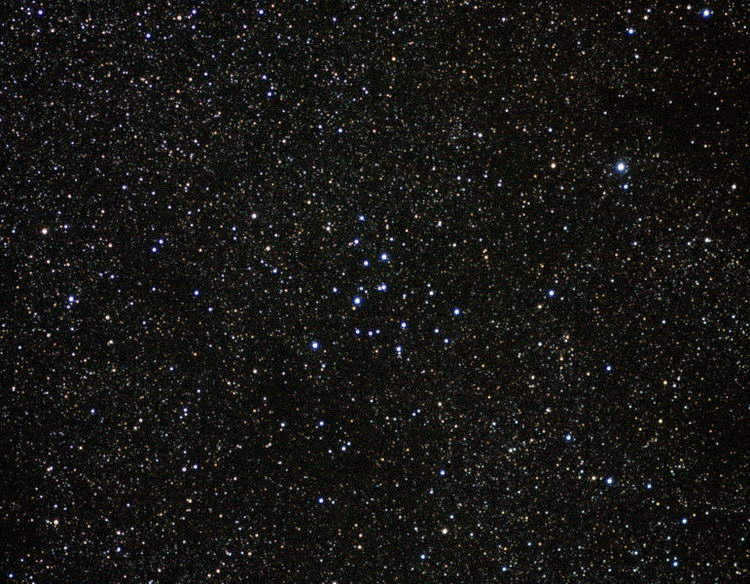
After leaving Deneb, we will shift approximately 8 degrees towards the North-East, where our next point of interest awaits – the dispersed cluster known as M39. Even with a basic pair of binoculars, we can observe around twenty-four stars gathered together in a distinctive heart-shaped formation. If you have access to a larger telescope, you may even notice a subtle blue hue emanating from the stars.
M29 is the subsequent and ultimate entity in this constellation from the collection of Messier. You might want to search for it approximately two degrees away from Sadr (γ Cyg). When observed through small binoculars, this group of stars appears as a condensed and highly concentrated cluster with a radiant aura surrounding it. At a magnification of 20 – 30x, the cluster disbands into about twelve bright stars positioned in an intriguing geometric formation, which includes both a rectangle and a triangle.
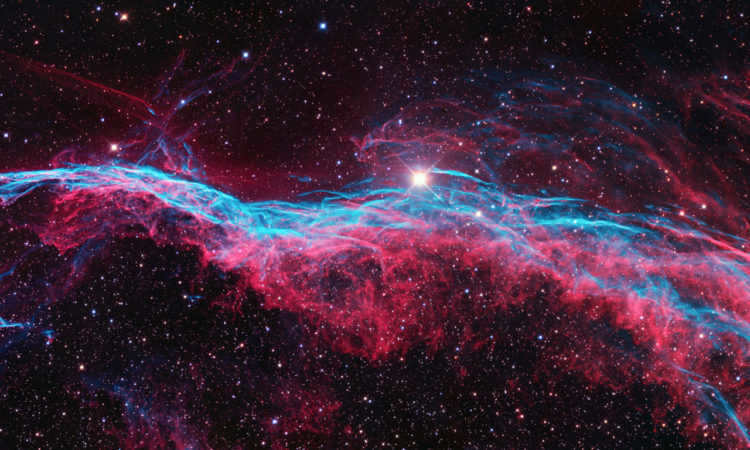
There is another fascinating object situated almost at the midpoint of the straight line that connects ε and ζ Cyg (approximately 0.5 degrees to the Southwest). This particular nebula is the remains of a supernova explosion that occurred in the constellation around 5,000 to 8,000 years ago. It is now referred to as NGC 6992 or the Veil Nebula. Because of its relatively short distance from Earth (only 1400 light years), the Veil Nebula provides us with a wealth of intricate features that can be observed even with low-aperture telescopes.
It is relatively easy to observe all three parts of the nebula in a medium telescope with a lens diameter of 90 – 120 mm. Nebulae can even be confidently viewed with a direct glance. However, a telescope with a larger aperture, ranging from 6″ to 8″, is able to reveal the intricate details of fine dust fibers, allowing for a much clearer view.
It is important to note that using more powerful instruments for observation can bring some discomfort, as the entire nebula may not fit within the field of view. Instead, you may have to navigate through its flow. Nevertheless, the most impressive observations of nebulae can be made using large astronomical binoculars.
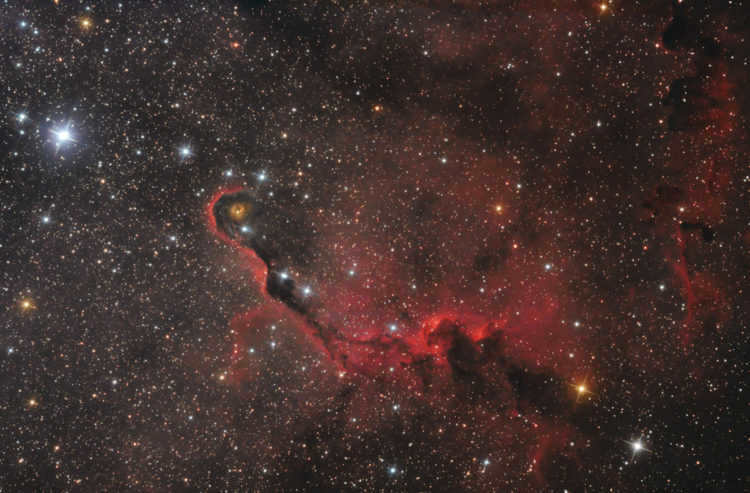
NGC 6960, also known as the Witch’s Broom, is another component of the supernova remnant. It is relatively easy to locate due to the presence of a bright blue-white star called 52 Cyg, which is situated near its center. Unlike the nebula, the Witch’s Broom is not directly associated with it and is actually much closer to us, appearing to be projected onto the supernova remnant.
The Witch’s Broom exhibits the same level of brightness as the Veil. When observed through a small telescope, it stands out noticeably against the backdrop of the Milky Way, resembling a sparkling stream of light that extends from East to West. To fully appreciate the intricate filigree patterns within the Witch’s Broom, a powerful telescope with an aperture of 6″ or larger is required.
Leaving Deneb behind, let’s direct our gaze to the Northeast, armed with a pair of binoculars. This region is teeming with numerous clusters scattered throughout. If we move towards the South-South-East from the previously observed M39, we will come across NGC 7082 and 7039.
These clusters are particularly noteworthy, as each of them showcases a multitude of individual stars that can be easily spotted through binoculars. Against the dazzling backdrop of the Milky Way, these luminaries stand out, creating a mesmerizing sight.
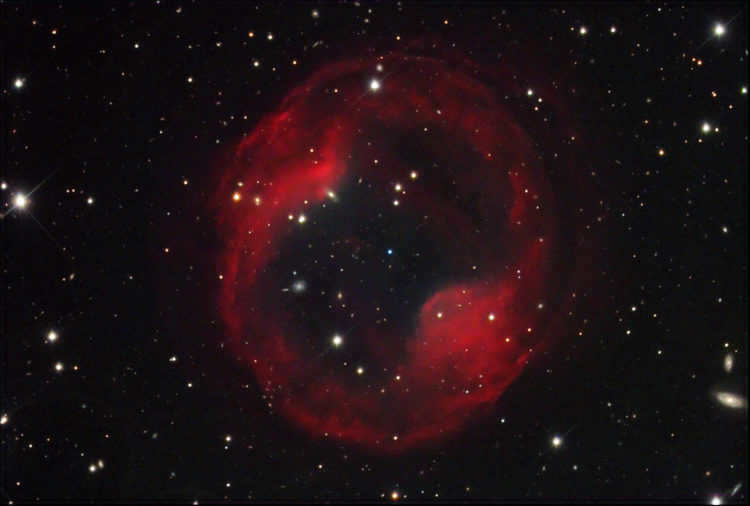
There are a minimum of two additional planetary nebulae with a stellar magnitude of ten in the constellation Cygnus. One of these, PK 64+5.1, is the most luminous and can be found roughly three degrees to the north-northwest of Albireo (β Cyg). To locate the nebula, we must first move upward from Albireo for approximately two degrees until we reach a star with a magnitude of 4.8. Adjacent to this star, about one degree to the northeast, is a brighter star with a magnitude of 3.9. The nebula can be found at the northwest apex of an equilateral triangle.
When observed through almost any telescope, this object appears as a small, slightly blurred star with a magnitude of 9.6. Due to its star-like appearance, there may be some difficulty in locating it. To confirm that it is not a star, a magnification of around 80x to 100x is necessary.
There is another planetary nebula, measuring 9.8m, situated near ι Swan. This particular nebula is famously known as the Hubble Shimmering Nebula and is listed as number 6826 in the New General Catalog. To locate it, you can follow these directions: two degrees to the Southeast of ι Cyg, you will come across a visually multiple star. This star is slightly dimmer than the starting star and one of its components is the variable R Cyg. From this star system, travel 1.5 degrees East-Northeast, and you should be able to find NGC 6826.
One way to verify if you have found the correct location is to look half a degree to the North from where the nebula is supposed to be. If you see a graceful chain of stars forming an arc, then you are on the right track.
This particular trait is observable in telescopes that have an aperture of 100 mm or greater. In smaller devices, however, it can be challenging to spot this phenomenon: despite its luminosity, the nebula is relatively small and could easily be misconstrued as a star. Nonetheless, perseverance and hard work will pay off, as the heavens will eventually reveal this marvel of the cosmos.
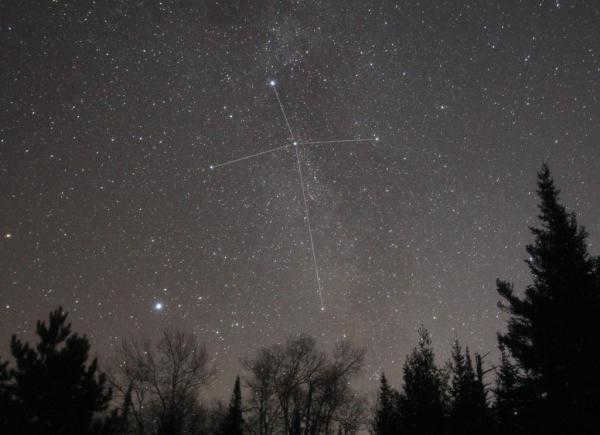
The constellation is easily visible all over Russia, except for the northern regions during the white nights. In other regions, the optimal time for observing the constellation is during the summer and autumn seasons.
Locating the constellation is relatively simple, as the star Deneb is part of a well-known formation called the “Summer Triangle”. To the west of the Swan is Vega, one of the brightest stars in the night sky (part of the Lyra constellation). In the east, you can find the “square” of Pegasus, and in the south, Altair makes the Eagle constellation clearly visible.
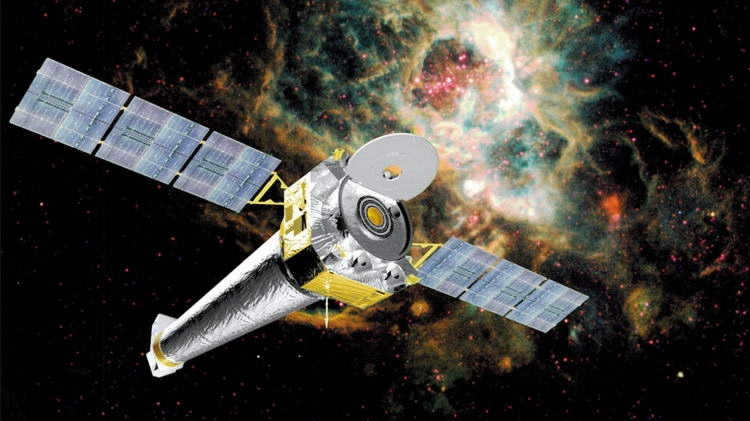
Astronomers and physicists have recently made a groundbreaking discovery in the Swan constellation – the identification of a black hole. This celestial object has captivated the minds of scientists for over two centuries, with early mentions of its existence dating back to the 18th century by the renowned mathematician Pierre-Simon Laplace. Although not referred to as black holes at the time, Laplace’s observations were based on the law of universal gravitation. It is now understood that in order for an object, such as a spacecraft, to escape the gravitational pull of Earth indefinitely, it must reach the second cosmic velocity, also known as the parabolic velocity, which is equivalent to 11.2 km/sec.
Given that these black holes do not emit light, it was not anticipated that they would be visible in telescopic observations. Nonetheless, in the early 1970s, when an X-ray telescope was deployed in space, astronomers detected radiation from celestial objects within a wavelength range that was previously inaccessible for observations conducted from the Earth’s surface due to significant absorption in the atmosphere.
The initial hypothesis that this enigmatic entity is a neutron star was promptly dismissed, as neutron stars typically have masses no greater than a few times that of the Sun. Scientists have deduced that the emission of X-rays is attributable to a black hole, which possesses a radius of merely 30 km. However, black holes themselves are incapable of emitting anything. So, how do we account for the presence of X-rays? Research has revealed that the black hole orbits a massive, scorching normal star, and its gravitational pull causes it to accrete matter. This matter forms an intensely hot disk around the black hole, reaching temperatures in the millions of degrees and generating the observed X-ray radiation.

